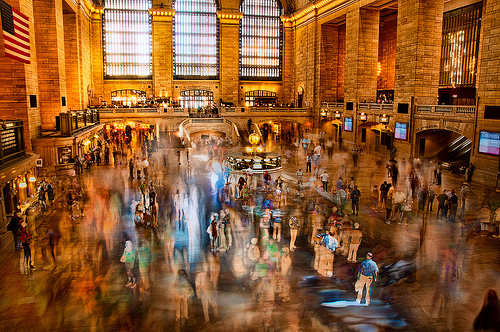Wandering around New York with my camera after an absence of many years was in some ways a dissonant experience. I grew up in New York City, but the New York of today is not the New York I remember from the years of my youth and as a young adult.
Of course, one can’t go home again and the only thing constant is change. But somehow this visit to my old stomping grounds made me feel particularly spectral, as if the photographer Harold of thirty years ago was also present and sensing my contemporary presence. To the Harold of the past I would have seemed like a ghost, inhabiting a future world that would have been almost unimaginable.
Past and present merged as one, and I tried to express this very odd feeling in my image of Grand Central Station and its ghosts.

How this image was made: When I walked through Grand Central Station I knew that I wanted to show this vast public space filled with people, many of whom would be partially blurred and therefore “ghosts.” Obviously, to achieve this effect I needed a long exposure.
The first hurdle was that when I took out my tripod a gentleman in camouflage khakis carrying an automatic weapon came over and told me I couldn’t use it. This was in keeping with much of my experience trying to photograph in New York—pulling out my tripod often led to its prohibition.
So I found a balcony railing on which I could rest my camera.
The next problem was that there was too much light for a long exposure. I solved this issue in two ways. First, I added a neutral density filter that cut the amount of light coming into my camera by a factor of 8. I then made a series of exposures at 4 seconds, f/22 and ISO 100.
The second way to extend the exposure was to rely on stacking. Stacking is a post-processing method for effectively extending the length of an exposure by aggregating shorter exposures. A common use is to extend the effective time of night exposures to create circular star trails as in Stars My Destination.
By extending the exposure time using a small aperture, a neutral density filter, and stacking I accomplished the intermittent blur I was looking for. People who stood still appeared solid and “real,” while those who were moving became spectral and blurred ghosts.
In this image I used the technique of stacking a little differently from stacking star trails, in which one wants the brightest pixel in a stack to be the one selected: In Ghosts of Grand Central I made two stacks, each consisting of six images, for an aggregate exposure length of 24 seconds. In one of the stacks I elected to choose the darkest pixel at each point. This is accomplished in the Photoshop Statistics action by setting the stack mode to Minimum.
The second stack used the Range stack mode, which is a statistical method that renders the spread between the darkest and lightest pixel at every point.
I combined the two stacks using a gradient, so the background of Grand Central Station (created with the Minimum stack) looked fundamentally as it does in “real life. But the foreground and floor of the space, created in the Range mode, was spectral and ghostly with some figures rendered normally and others as negative space.
Pingback: Things You’ll Find Interesting September 29, 2012 | Chuq Von Rospach, Photographer and Author
Pingback: At Home in the Universe